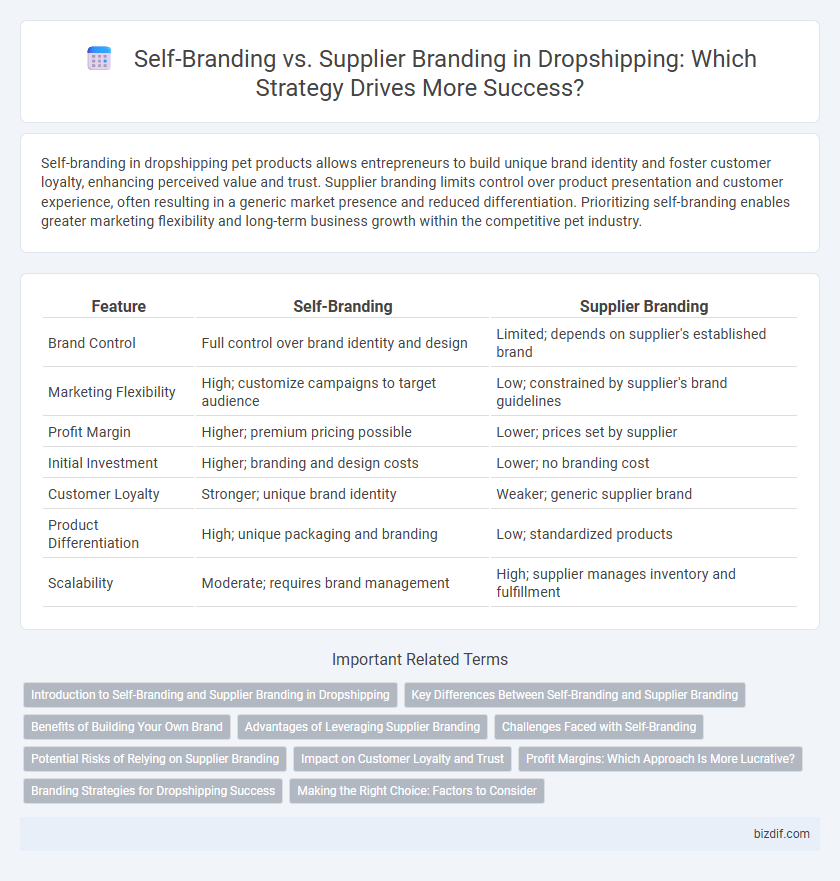Self-branding in dropshipping pet products allows entrepreneurs to build unique brand identity and foster customer loyalty, enhancing perceived value and trust. Supplier branding limits control over product presentation and customer experience, often resulting in a generic market presence and reduced differentiation. Prioritizing self-branding enables greater marketing flexibility and long-term business growth within the competitive pet industry.
Table of Comparison
| Feature | Self-Branding | Supplier Branding |
|---|---|---|
| Brand Control | Full control over brand identity and design | Limited; depends on supplier's established brand |
| Marketing Flexibility | High; customize campaigns to target audience | Low; constrained by supplier's brand guidelines |
| Profit Margin | Higher; premium pricing possible | Lower; prices set by supplier |
| Initial Investment | Higher; branding and design costs | Lower; no branding cost |
| Customer Loyalty | Stronger; unique brand identity | Weaker; generic supplier brand |
| Product Differentiation | High; unique packaging and branding | Low; standardized products |
| Scalability | Moderate; requires brand management | High; supplier manages inventory and fulfillment |
Introduction to Self-Branding and Supplier Branding in Dropshipping
Self-branding in dropshipping involves creating a unique brand identity that distinguishes your store and products from competitors, enhancing customer loyalty and perceived value. Supplier branding relies on the manufacturer or wholesaler's established brand, reducing marketing effort but limiting control over brand perception and customer experience. Understanding the balance between self-branding and supplier branding is crucial for optimizing dropshipping business strategies and long-term growth.
Key Differences Between Self-Branding and Supplier Branding
Self-branding in dropshipping involves creating and promoting a unique brand identity, including custom packaging, logos, and personalized marketing strategies, which enhances customer loyalty and perceived value. Supplier branding relies on the supplier's established brand, limiting control over product presentation and customer experience but reducing upfront branding costs. The key differences lie in control over brand image, investment in marketing, and long-term brand equity development.
Benefits of Building Your Own Brand
Building your own brand in dropshipping enhances customer loyalty by creating a unique identity that differentiates your products from competitors. Self-branding enables better control over marketing strategies, pricing, and product quality, increasing profit margins and long-term business value. This approach also fosters trust and recognition, which drives repeat purchases and strengthens your presence in the market.
Advantages of Leveraging Supplier Branding
Leveraging supplier branding in dropshipping allows merchants to capitalize on established brand recognition and trust, reducing marketing costs and accelerating customer acquisition. Suppliers typically invest heavily in product development and quality assurance, ensuring consistent standards that enhance buyer confidence. This approach also streamlines inventory management and minimizes risks associated with product sourcing and fulfillment.
Challenges Faced with Self-Branding
Self-branding in dropshipping presents challenges such as the need for significant upfront investment in marketing, creating a unique brand identity, and maintaining consistent customer engagement to build trust. Sellers must handle product customization, quality control, and brand reputation management without direct control over suppliers. Establishing credibility while competing against established supplier brands requires strategic branding efforts and continuous optimization of customer experience.
Potential Risks of Relying on Supplier Branding
Relying on supplier branding in dropshipping exposes businesses to significant risks such as lack of control over product quality and inconsistent customer experience, which can damage brand reputation. Suppliers may change packaging, discontinue products, or alter pricing without notice, leading to unpredictable supply chain disruptions. This dependency undermines long-term brand loyalty and limits opportunities for differentiation in competitive markets.
Impact on Customer Loyalty and Trust
Self-branding in dropshipping enhances customer loyalty and trust by creating a unique and consistent identity that resonates with buyers, fostering long-term relationships. Supplier branding, while convenient, often limits differentiation and may lead to weaker customer attachment due to inconsistent quality perceptions. Prioritizing self-branding boosts repeat purchases and positive reviews, crucial for sustained business growth in competitive dropshipping markets.
Profit Margins: Which Approach Is More Lucrative?
Self-branding in dropshipping typically offers higher profit margins by allowing greater control over pricing and customer perception, leading to enhanced brand loyalty and repeat sales. Supplier branding often involves lower upfront costs but results in thinner margins due to competition and preset wholesale prices. Prioritizing personalized packaging and direct customer engagement amplifies profitability in self-branded dropshipping ventures.
Branding Strategies for Dropshipping Success
Self-branding in dropshipping establishes a unique identity, fostering customer loyalty through personalized marketing, exclusive packaging, and consistent brand messaging. Supplier branding relies on the reputation and quality of third-party providers, often limiting customization but reducing upfront costs and fulfillment complexity. Effective dropshipping strategies balance self-branding's differentiation advantages with supplier branding's operational efficiencies to optimize long-term success and customer retention.
Making the Right Choice: Factors to Consider
Choosing between self-branding and supplier branding in dropshipping involves evaluating control over customer experience, profit margins, and brand identity development. Self-branding allows for greater customization and stronger customer loyalty, while supplier branding often requires less upfront investment and simpler operations. Factors such as target market preferences, long-term business goals, and marketing capabilities play a crucial role in making the right choice.
Self-Branding vs Supplier Branding Infographic

 bizdif.com
bizdif.com